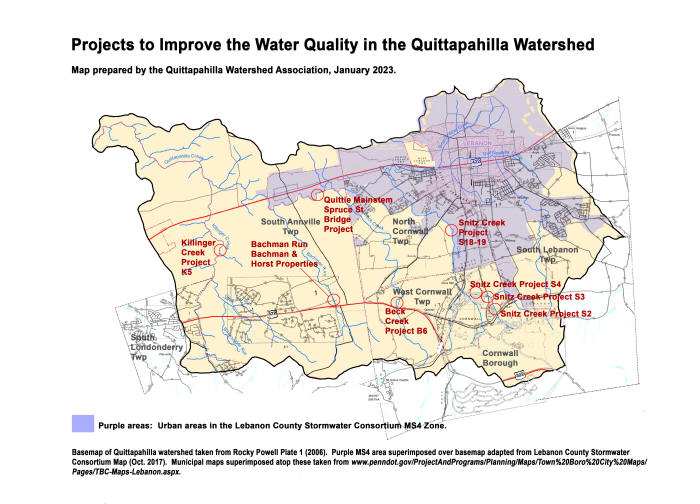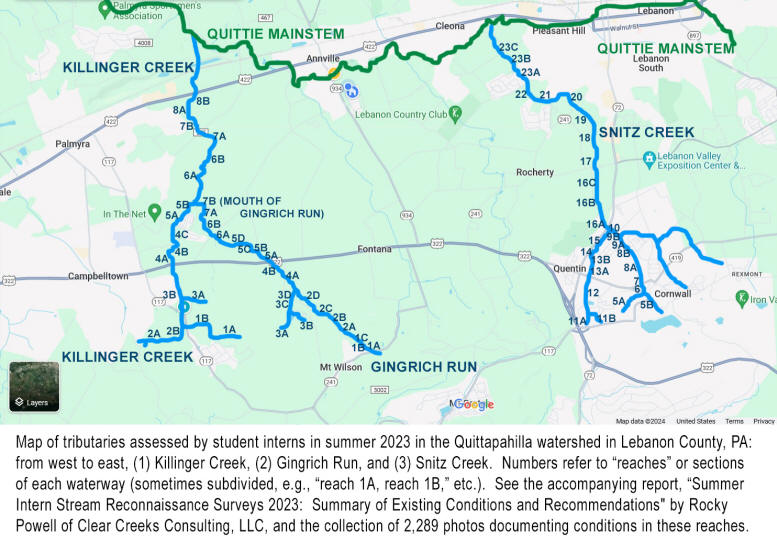This page offers a brief overview of the main projects and initiatives the QWA has pursued in recent years, focusing on:
1. Stream Restoration Projects in the Quittapahilla Watershed, 2023-2025
2. Quittie Watershed Monitoring Program (QWMP), 2018-2025
3. Student Summer Internship Program, 2023 & 2024
4. NFWF Grant, 2024-2025
5. Education & Outreach
6. Showcase Project, 2014-2015: Quittapahilla Creek Stream Restoration Project in Annville
7. Related & Past Initiatives
1. Stream Restoration Projects in the Quittapahilla Watershed, 2023-2025
Click on the image below for a bigger and easier to read version:
The map above, created in January 2023 but still accurate in fall 2024, shows the ongoing projects in the Quittapahilla watershed that the QWA is directly supporting.
Of course, we support all projects in the watershed intended to improve water quality and decrease the amount of sediment and pollutants flowing down to the Chesapeake Bay. But in practical terms, we've divided the labor between ourselves in the QWA and the area under the jurisdiction of what's known as the "Lebanon County Stormwater Consortium," the area shown in purple in the above map.
The Consortium is comprised of six municipalities that are considered "urban" and therefore under EPA mandate for MS4-related reductions ("MS4" stands for "Municipal Separate Storm Sewer System"). The six municipalities in the Consortium are: (1) the City of Lebanon, (2) North Lebanon Township, (3) South Lebanon Township, (4) North Cornwall Township, (5) Cleona Borough, and (6) Annville Township.
The Quittapahilla Watershed Association, on the other hand, has taken responsibility for pretty much everything else -- including all the tributaries that flow into the Quittapahilla, most prominently (moving from east to west), Snitz Creek, Beck Creek, Bachman Run, and Killinger Creek.
From east to west, these projects are:
• Snitz Creek Project 2 in Cornwall Borough
• Snitz Creek Project 3 in Cornwall Borough
• Snitz Creek Project 4 in Cornwall Borough
• Snitz Creek Project 18-19 in North Cornwall Township (stuck because of landowner refusal)
• Beck Creek Project 6 in North Cornwall Township
• Quittapahilla Mainstem at Spruce St. Bridge Project in Annville Township
• Bachman Run, Bachman & Horst Properties in South Annville Township
• Killinger Creek Project 5, Huber & Burkholder Properties in South Annville Township
Detailed project descriptions, location maps, site maps, and much more information on each of these projects are housed on the "Studies & Documents" page of this website.
2. Quittie Watershed Monitoring Program (QWMP), 2018-2025
The basic idea behind our monitoring program is to assess the extent to which the restoration work undertaken in the watershed is having its intended effects. Is the amount of sediment and pollutants (mainly nitrogen & phosphates) being flushed downstream to the Chesapeake Bay really declining? Are the little water-bugs (macroinvertebrates) more numerous and diverse after the restoration work has been completed? Is the water in the watershed really getting cleaner?
To do this work, we have embarked on an ambitous, all-volunteer program to monitor four interrelated features of the waterways comprising the watershed:
1. Geomorphic status
2. Habitat conditions
3. Invertebrate communities
4. Water quality
Spearheaded by QWA Board member Dr. J. Kent Crawford, now retired from a long career with the U.S. Geologic Survey (USGS), our monitoring program is described in greater detail on the Monitoring page of this website. As noted on that page, our Monitoring Program is currently being led by the following team leaders:
Fieldwork Coordinator: Katie Hollen
Equipment Manager: Kara Lubold
Data Management: Bob Connell and Alyssa Bellucci
Communications Manager: Michael Schroeder
Our current schedule has us undertaking streamflow and water quality measurements and taking water samples from all six monitoring sites to the PA-DEP lab in Harrisburg every two months. Be in touch if you are interested in lending a hand!
Below: Photo of QWA President Michael Schroeder and fellow QWA volunteer Bob Connell undertaking streamflow measurements on Killinger Creek in fall 2022.
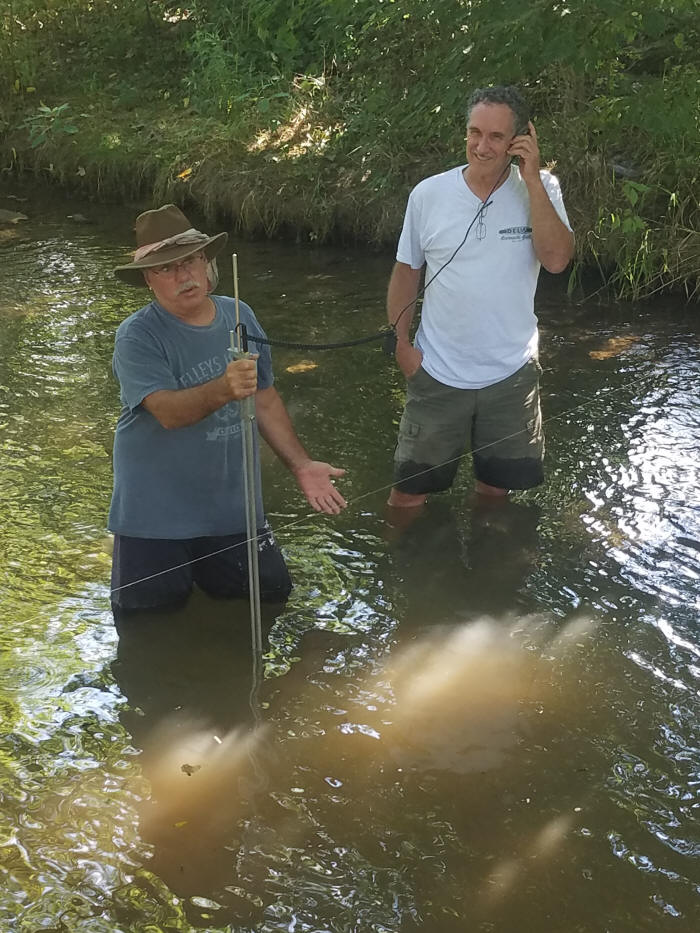
3. Student Summer Internship Program, 2023-2024
For the past two years, the Lebanon County Conservation District has provided funds two college students to work full-time for 10 weeks to assess conditions in the tributaries flowing north into Quittie Creek from the mountains to the south: Snitz Creek, Beck Creek, Bachman Run, and Killinger Creek (including Gingrich Run). The flier announcing our 2024 summer internship program appears below.

Starting in summer 2017, the QWA organized three
successive paid summer internships for college
students. The goal of these internships was to
update the stream assessments undertaken by
Rocky Powell in the early 2000s, assessments
that form the basis of his multi-volume 2006
study which essentially forms the roadmap for
our 2021 WIP and all of our ongoing work in the
watershed (that multi-volume work is housed on
the Studies & Documents page of this website
under the date of December 2006)
Things can change a lot in 20-plus years. The streams
that Rocky walked and assessed back in 2000-2001
have seen many changes, with new housing and
commercial developments, changes in land use
with cropland and livestock, continuing
streambank erosion, and more. So we began this
internship program with an eye toward keeping
the 2006 study fresh and updated — especially
along the tributaries that are the focus of our
work: mainly Snitz Creek, Beck Creek, Bachman
Run, and Killinger Creek.
So, in partnership with The Lebanon Valley Conservancy, the QWA ran
the Summer Internship Program in 2017 (on Snitz
Creek), 2018 (on Beck Creek), and 2019 (on
Bachman Run) thanks to three successive $1,500
grants from Pennsylvania Trout Unlimited, and
with an additional support from North Cornwall
and South Annville townships. Run on a
shoestring, the program yielded some valuable
data, but not enough for what we needed, and
need.
Then came the Covid-19 pandemic, and we were forced to suspend the
program for the summers of 2020, 2021, and 2022.
Fortunately, we were
able to secure additional funding and
expand the program in summer 2023 to
create two full-time summer jobs for
qualified college students.
Starting in early June and continuing into
mid-August, two highly capable Environmental Science
majors from Lebanon Valley College, Hannah Horengic
and Ilyssa McLaughlin, undertook detailed
assessements of three tributaries: Gingrich
Run, Killinger Creek, and Snitz Creek. The map
below shows the tributaries and reaches they
assessed (a "reach" refers to a section of a
waterway, and can range in length from a few hundred
feet to upwards of 2,000 feet).
Click on the image below for a larger version of the same
map:
The 61-page final report that resulted from the 2023 work (PDF file, 20 MB), prepared by Rocky Powell, offers a synopsis of their prinicpal findings and recommendations for remediating the most severely impacted stream reaches. As noted in the report's Introduction, "The 2023 summer’s interns initially focused on the Gingrich Run and Killinger Creek subwatersheds, but the effort was expanded to include Snitz Creek subwatershed. Funding for the 2023 Intern Program was provided by the Lebanon County Conservation District (LCCD) with grant administration provided by The Lebanon Valley Conservancy."
Accompanying the 2023 report are some 2,289 photographs documenting conditions in each of these reaches and sub-reaches. These photographs are housed in this Google Drive folder: https://drive.google.com/drive/folders/1gdm9cydCi8WjCa-N7X-jT8Kk_C1MAv97?usp=sharing
A similar report resulted from the work of our two summer 2024 student interns. We were pleased to bring LVC Environmental Science major Hannah Horengic on board again, and to team her up with Ben Mitchell, a Lebanon County native majoring in Geology and Biology at Colgate Unversity in New York. This 2024 report, completed in November, is also housed on the Studies & Documents page of this website.
Unfortunately, reading these two reports requires looking at three different types of information at the same time:
1. The map of the reach or sub-reach being described,
2. The summary of conditions in that reach or sub-reach from the tables in the final report, and
3. The photographs of the reach or sub-reach.
We are currently looking into ways to present this material in a more reader-friendly fashion, for example using a story map.
Below: photos of Brittany Weaver (first pic) & Kyla O'Connor working hard undertaking a geomorphic assessment of Beck Creek & having fun doing it on their summer 2018 internship.
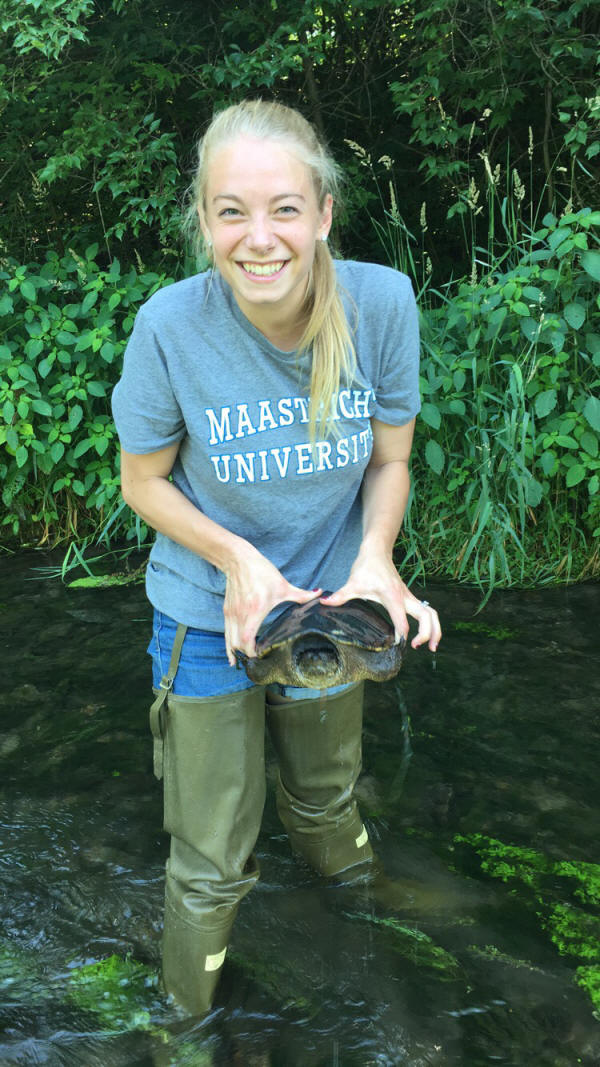
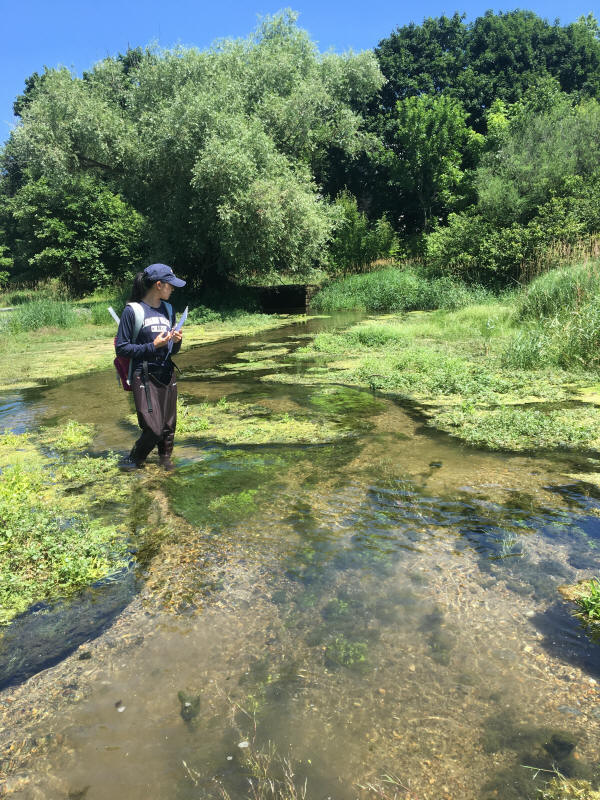
4. NFWF Grant, 2024-2025
Section forthcoming.
5. Education & Outreach.
Section forthcoming.
6. Showcase Project, 2014-2016: Quittapahilla Creek Stream Restoration Project in Annville
This project took about 16 years from beginning to end. The final phase, dubbed "Phase 2," began in July 2016 and was mostly completed by late September 2016. Phase 2 was made possible thanks to a $422,462 Growing Greener Grant from PA-DEP. The funds for Phase 2 came atop the $444,126 Growing Greener grant and $80,000 from the PA Fish & Boat Commission for Phase 1, awarded in 2014 -- bringing the grand total for Phases 1 & 2 to nearly $1 million ($946,588). Studies that made the work possible began around the year 2000.
The following organizations & businesses combined efforts to make this project happen:
• Lebanon Valley Conservancy (overall project management & administration, finances, reports)
• Quittapahilla Watershed Association (oversee re-vegetation, coordinate with landowners, monitor annually)
• Lebanon Valley College (pre- and post-construction biological surveys & monitoring)
• Pennsylvania Fish & Boat Commission (post-construction habitat evaluation)
• Clear Creeks Consulting, LLC (professional services for project coordination)
• Sylva Native Nursery & Seed Co (matching for planting materials)
• Aquatic Resources Restoration Company (did the work)
A week-to-week photoblog on the Stream Resoration Project can be found under "Photos & Images" at left, under the sub-tab Restoration 2014-16. Work on this major & important project began on Monday, November 10, 2014, and was formally inaugurated a week later, on Nov. 17, with a ribbon-cutting ceremony at the Raymond Swingholm Pedestrian Bridge off Bachman Road in Annville. The goal of the project was to restore 3,450 linear feet of Quittie Creek — about two-thirds of a mile (0.65 of a mile), from 150 yards upstream of the Old Mill Dam in Quittie Creek Nature Park to just upstream of the 934 Bridge, as shown on the Site Location Map below. Phase 1, covered by the Growing Greener and Fish & Boat Commission grants and mostly completed on 19 February 2015, removed most of the concrete remnants of the Old Mill Dam and restored approximately 1,750 linear feet of streambank and stream channel, starting about 150 yards upstream of the Pedestrian Bridge and continuing a couple of hundred yards past Stumpy's Little Footbridge off Bachman Road. Phase 2, which took the project down nearly to the Route 934 (White Oak St.) Bridge, saw its formal conclusion at the closeout meeting of Monday, October 3, 2016.
This project will remain prominently listed on this Projects & Grants page because it was a big project and a big success.
The area encompassed by both Phases 1 & 2 is shown in the map below:
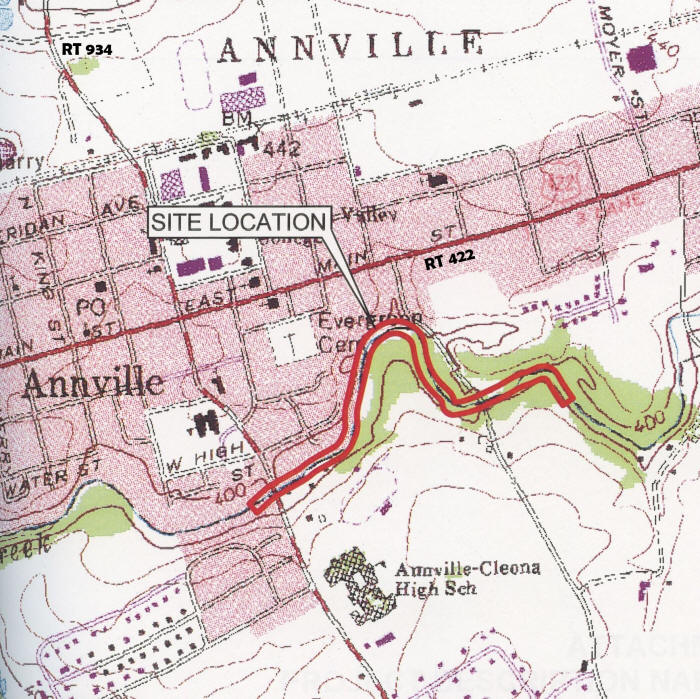 |
Site Location Map detail adapted from USGS (7.5 min. quad.) Palmyra & Lebanon PA as modified by Skelly & Loy, Inc. June 2012, Fig. 1, Attach. G.
7. Related & Past Initiatives
Good news! Our long-awaited Quittapahilla Creek Watershed Implementation Plan -- our WIP 2021 -- has been officially approved by both PA-DEP and the federal EPA.
We are proud of this document. Authored by Rocky Powell of Clear Creeks Consulting, LLP, the WIP 2021 is the result of nearly 20 years of scientific research into the principal characteristics & impairments of our watershed, and looks ahead to the next 20 years to provide a detailed roadmap for improving the quality of the water flowing into the Chesapeake Bay.
The WIP 2021 is housed on the Studies & Documents page of this website. The direct link to the document is HERE.
Lebanon County Countywide Action Plan (CAP)
Begun in Fall 2020, the Lebanon County Countywide Action Plan (CAP) is part of a larger EPA and PA-DEP-mandated program for all the Pennsylvania counties whose waters flow into the Susquehanna River and the Chesapeake Bay.
A sprawling & ongoing project with many moving parts, the CAP falls under the jurisdiction of and is administered by the Lebanon County Conservation District (LCCD). The QWA is represented on the CAP Steering Committee by President Michael Schroeder, who also chairs the CAP's Education & Outreach Action Team. More details can be found on this website under the tab on the navigation menu labeled, "CAP 2020 →".
The Lebanon County Conservation District's CAP webpages are here: https://www.lccd.org/cap
Major past projects
Here we list the major projects undertaken by the Quittapahilla Watershed Association since its founding in June 1997. See the materials housed on the Archives page of this website (the first item under "Photos & Images") for a more detailed look at each of these projects, including not only final reports but correspondence, photos, memos & notes, receipts, and related material. The prime mover & shaker for these and other projects was David Lasky, Professor Emeritus of Psychology at Lebanon Valley College, founder of the Quittapahilla Watershed Association, and its president until 2014, when he handed the reins to Michael Schroeder.
2009-2010. PA-DEP Growing Greener Grant to study work in Annville, completed in 2010, to prepare a plan to stabilize 3,300 feet of stream bank. Grant amount: $90,000.
2008-2010. PA-DEP Growing Greener Grant BMP3 2008, completion in 2010. To create a wetland to remove sediment and phosphorous. Grant amount: $250,000.
2006. National Fish and Wildlife Foundation Grant for sediment study. Completed. Grant amount: $25,000.
2005-2006. PA Fish & Boat Commission grant to stabilize the stream bank in Cornwall Borough Park. Final Report submitted 2/1/07. Grant amount: $10,000.
2001-2006. PA-DEP Growing Greener Assessment Grant - 1B. Completed. Grant amount: $282,000.
2000-2001. PA-DEP Growing Greener Assessment Grant 1A. Completed. Grant amount: $175,000.
2003. Cleona Park mitigation grant to stabilize the stream bank in Cleona Park, $3,600.
2000-2001. PA-Department
of Community & Economic Development (PA-DCED) Grant for
developing an educational wetland involving four
school districts and Lebanon Valley College. Final Report submitted 2003. Grant amount:
$14,000.00
DEP construction work at wetland. Final Report
submitted 2003. Grant amount: $37,000.
2000-2002. PA-DEP Growing Greener Grant & PA-DCNR Grant. Work on four farms on Little Swatara Creek: installation of 9,825 feet of streambank fencing and planting of riparian buffers. Final Report submitted 6/30/2003. Grant amounts: PA-DCNR: $14,513.60. PA-DEP: $19,425.
2000-2002. PA-DEP Growing Greener Grant for the Hammer Creek: 9,916 feet of streambank fenced and riparian buffers planted on six farms. Final Report submitted 6/30/2003. Grant amount: $56,618.67.
2001. U.S. Fish & Wildlife Service grant for component of assessment study. Completed. Grant amount: $5,000.
1999-2000. PA-DEP Watershed Restoration Grant. 10,115 feet of stream bank fenced and riparian buffers planted on seven farms. Final Report submitted 6/30/2000. Grant amount: $28,204.59.
1998-1999. PA-DEP Watershed Restoration Grant. 25,451 feet of stream bank fenced and riparian buffers planted on eleven farms. Final Report submitted 6/30/1999. Grant amount: $44,844.45.
1998-2002. Over three tons of trash collected from the watershed in multiple community cleanups organized or sponsored by the QWA.
